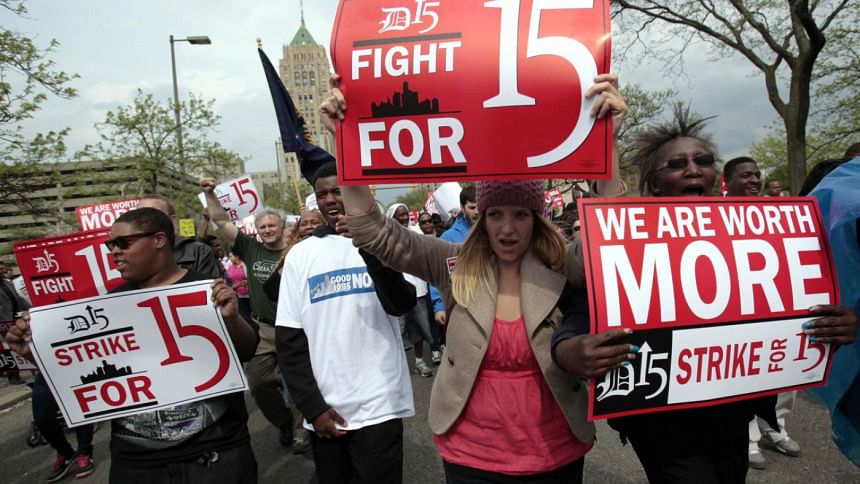Why wages don't rise with a tighter labour market

As the US celebrated Labour Day on September 3, millions of the working majority were wondering what happened to the powerful labour unions or the promise of rising wages in a growing economy. Unlike the May Day holiday observed in other countries, Labour Day in the US is anything but a celebration of labour power or a show of strength for better working conditions. And the mystery persists: Why are real wages stagnant in a booming economy? Even the Wall Street Journal (WSJ), the mouthpiece of US business, echoed this puzzlement. "One of the lingering mysteries of the economic expansion that began nearly nine years ago: Why has growth in Americans' paychecks remained anaemic despite the unemployment rate plunging to its lowest level in 17 years?" it moaned.
The disconnect between wage gains and falling unemployment is creating a bit of headache for the academics and policymakers. Until recently, it was held as an axiom that if the unemployment rate falls, the tighter labour market leads to an acceleration in wage gains. To put it simply, lower unemployment level raises the compensation for workers, i.e. wages. This simple relationship, known as the Phillips Curve, has been a lynchpin of almost all standard economic models. The Phillips Curve has not been working, or has been weak, as evidenced by recent experience in all major market economies. With the US mid-term elections approaching, the media and political commentators—not to speak of economists—are now scrambling to come up with plausible explanations for low wage growth in the last decade.
You can hear the rumblings everywhere: "Workers are not getting their fair share of the pie or the fruits of their labour." Senator Bernie Sanders pronounced that wage gains were zero last year due to inflation, and added, "The average American worker today, despite the strong economy, is not getting ahead." And this frustration can be heard across the Atlantic and the Pacific. "The traditional relationship between economic growth and pay growth seems to have broken down in a significant number of mature economies," says Duncan Brown of the Institute for Employment Studies in the UK. "There's evidence that the rate of pay growth has slowed even as economies have recovered. In some cases, that means real incomes have stagnated. That's something we've probably not [sic] since the 1860s or 1870s."
BBC Capital goes even further: "While many national economies are growing and companies report higher profits a decade after the financial crisis, only those at the very top are feeling the benefit. The cost of living has increased, but many workers have not seen their salaries rise accordingly and are worse off than they were a few years ago."
In the US, as in any other country, the economy is a thorn on the side of any incumbent seeking re-election. If things do not go as planned, or as the candidate promised during the previous election, evidence of increasing unemployment or inflation, or falling wages, become a deal-breaker. For example, when the Conservative party won the Brexit referendum in the UK in 2016, supporters of the Leave movement assured the British electorate that the UK would be a big winner financially should it choose to get out of EU. Well, nobody is repeating that rosy scenario as the B-Day, March 29, 2019, approaches. In the US, the mid-term elections are due on November 6, 2018 and while the economy is in good shape, one of the key promises made by President Trump during the 2016 elections remains elusive. As a candidate, Trump excoriated his predecessor for slow growth in workers' incomes, lambasting Obama for not working hard enough to raise the wages of America's "forgotten man and woman". "Household incomes are over USD 4,000 less today than they were 16 years ago," he had said during a campaign rally in Pensacola, Fla., in September 2016. "We'll get your salaries and your wages up, up, up."
Guess what! Trump's promise of higher real wages did not materialise. According to a report by Bloomberg News, "Real wages have remained mostly stagnant, despite an expanding economy, record stock prices, soaring corporate profits, and a giant deficit-fuelled stimulus from Trump's tax cuts." Once the impact of inflation is included, ordinary Americans' hourly earnings are lower than they were a year ago. Even WSJ on September 8 wrote, "According to the Bureau of Labor Statistics' latest report on real earnings, as of July average hourly earnings had increased 2.7 percent over the preceding year, while inflation was 2.9 percent, due in large part to a surge in oil prices—a slight decrease in real terms."
The mystery of the zero or low wage gains has bedevilled academic journals, not to speak of popular media that have been searching for an acceptable explanation of the demise of the Phillips Curve. Some academics have used powerful quantitative tools to prove that the Phillips Curve has flattened. Others point the finger at weaker unions, an aging population, and low growth of labour productivity. Some others have advanced the hypothesis that overseas competition as well as the pool of underemployed has exercised a restraining effect on wage growth. The more quantitative economists are arguing that the "natural rate of unemployment" is much lower than the 4 percent previously considered, and that means that the theory is solid but the data is lying.
What does all this mean for policymakers? First of all, one cannot count on falling unemployment or job growth to automatically improve workers' income. Minimum wage laws must be enforced and labour unions and better training and education need to be supported. To quote Prof. John Buchanan of the University of Sydney Business School, "Institutional agencies and minimum wage structures emerged to discipline employers, so if you weaken them then you take that discipline away." Some progressive parliamentarians such as Senator Elizabeth Warren in the US have introduced legislation to require corporations to nominate employees to their board of directors. The Accountable Capitalism Act is an effort in that direction. Secondly, central bankers have so far blindly relied on Phillips Curve to provide guidance on interest rate policy. However, if wage increases do not follow low unemployment, or do not trigger price increases, monetary policy can no longer be based on old economic models incorporating Phillips Curve!
As a result, one wonders if the major G-8 central banks—the Federal Reserve System, Bank of England, and the Bank of Japan—are currently operating with a broken compass. Prof. Alan Blinder of Princeton University and a former vice chairman of the Fed wrote in the Wall Street Journal a few months ago, "The Fed needs to know whether the Phillips Curve has died or has just taken an extended vacation."
Dr Abdullah Shibli is an economist and Senior Research Fellow, International Sustainable Development Institute (ISDI), a think-tank in Boston, US. His new book Economic Crosscurrents will be published later this year.

 For all latest news, follow The Daily Star's Google News channel.
For all latest news, follow The Daily Star's Google News channel. 








Comments